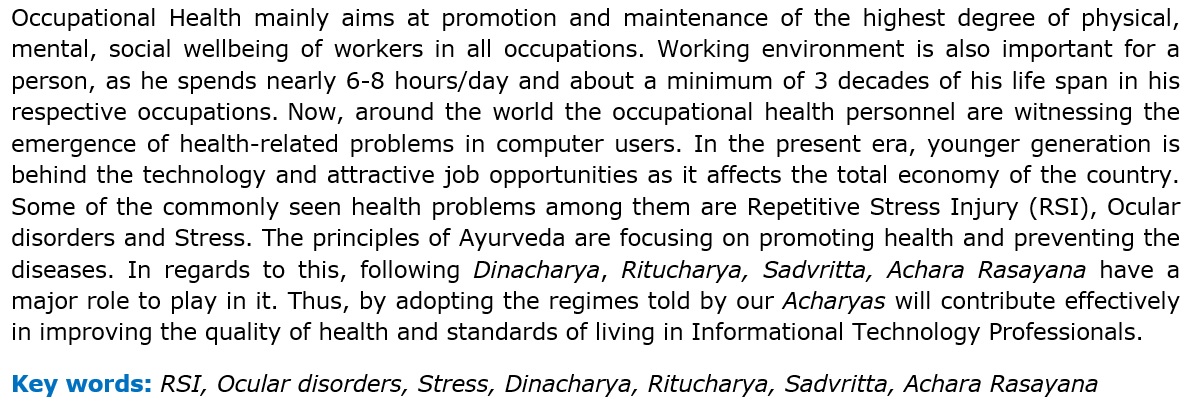Occupational health in information technology professionals - An Ayurvedic Purview
DOI:
https://doi.org/10.21760/jaims.v6i3.1313Keywords:
RSI, Ocular disorders, Stress, Dinacharya, Ritucharya, Sadvritta, Achara RasayanaAbstract
Occupational Health mainly aims at promotion and maintenance of the highest degree of physical, mental, social wellbeing of workers in all occupations. Working environment is also important for a person, as he spends nearly 6-8 hours/day and about a minimum of 3 decades of his life span in his respective occupations. Now, around the world the occupational health personnel are witnessing the emergence of health-related problems in computer users. In the present era, younger generation is behind the technology and attractive job opportunities as it affects the total economy of the country. Some of the commonly seen health problems among them are Repetitive Stress Injury (RSI), Ocular disorders and Stress. The principles of Ayurveda are focusing on promoting health and preventing the diseases. In regards to this, following Dinacharya, Ritucharya, Sadvritta, Achara Rasayana have a major role to play in it. Thus, by adopting the regimes told by our Acharyas will contribute effectively in improving the quality of health and standards of living in Informational Technology Professionals.
Downloads
References
2. Information technology. Wikipedia. (Accessed on 16.09.2020). Available form: https://en.wikipedia.org/wiki/Information_technology.
3. M Ashwin. Prevelance of repetitive strain injury, visual disorder and stress among I.T professionnals in bangalore city. 2010 (Accessed on 12.02.2019). Available form: http://52.172.27.147:8080/jspui/handle/123456789/7750
4. Everything you should know about repetitive strain injury (RSI). Health line. (Accessed on 12.01.2020). Available form: https://www.healthline.com/health/repetitive-strain-injury#risk-factors
5. What are the causes & preventive measures for computer vision syndrome?. Medlife. (Accessed on 12.01.2020). Available form: https://www.medlife.com/blog/causes-preventive-measures-computer-vision-syndrome/
6. Stress effects. The American Institute of stress. (Accessed on 12.01.2020). Available form: https://www.stress.org/stress-effects
7. Rao Srinivas P. Astanga Samgraha. Varanasi: Chowkhamba Krishnadas Academy. Volume 1, Sutra sthana, chapter 3, sloka no 27, 1st Ed, 2005; p26.
8. Rao Srinivas P. Astanga Samgraha. Varanasi: Chowkhamba Krishnadas Academy. Volume 1, Sutra sthana, chapter 3, sloka no 56-57, 1st Ed 2005; p 31.
9. Bhisagacharya Harisastri Paradakara Vaidya. Asthanga Hrudaya composed by Vagbhata with the commentaries of Arunadatta and of Hemadri. Varanasi: Chaukhamba Orientalia. Sutrasthana, chapter 2, sloka 10, 10th Ed, 2017;p27.
10. Bhisagacharya Harisastri Paradakara Vaidya. Asthanga Hrudaya composed by Vagbhata with the commentaries of Arunadatta and of Hemadri. Varanasi: Chaukhamba Orientalia. Sutrasthana, chapter 2, sloka 15-16, 10th Ed, 2017;p28.
11. Jadavaji Trikamji. Susruta Samhita of Susruta with the Nibandhasangraha commentary of Sri Dalhanacharya. Varanasi: Chaukhambha Orientalia. Chikitsa sthana. Chapter 24, shloka no 57, 2014; p489.
12. Jadavaji Trikamji. Susruta Samhita of Susruta with the Nibandhasangraha commentary of Sri Dalhanacharya. Varanasi: Chaukhambha Orientalia. Chikitsasthana. Chapter 24, shloka no 31, 2014; p488.
13. Jadavaji Trikamji. Susruta Samhita of Susruta with the Nibandhasangraha commentary of Sri Dalhanacharya. Varanasi: Chaukhambha Orientalia. Chikitsasthana. chapter 24, shloka no 29, 2014; p488.
14. Jadavaji Trikamji. Susruta Samhita of Susruta with the Nibandhasangraha commentary of Sri Dalhanacharya. Varanasi: Chaukhambha Orientalia. Sutra Sthana. Chapter 5, shloka no 15, 2013; p39.
15. Jadavaji Trikamji. Susruta Samhita of Susruta with the Nibandhasangraha commentary of Sri Dalhanacharya. Varanasi: Chaukhambha Orientalia. Sutra Sthana, chapter 5, shloka no 15, 2013;p39.
16. Jadavaji Trikamji. Susruta Samhita of Susruta with the Nibandhasangraha commentary of Sri Dalhanacharya. Varanasi: Chaukhambha Orientalia. Sutra Sthana, chapter 5, shloka no 32, 2013;p40.
17. Jadavaji Trikamji. Susruta Samhita of Susruta with the Nibandhasangraha commentary of Sri Dalhanacharya. Varanasi: Chaukhambha Orientalia. Chikitsa sthana. chapter 24, shloka no 29, 2014; p488.
18. Bhisagacharya Harisastri Paradakara Vaidya. Asthanga Hrudaya composed by Vagbhata with the commentaries of Arunadatta and of Hemadri. Varanasi: Chaukhamba Orientalia. Sutrasthana, Chapter 22, sloka no 23, 10th Ed, 2017; p301.
19. Rao Srinivas P. Astanga Samgraha. Varanasi: Chowkhamba Krishnadas Academy. Volume 1, Sutra sthana, chapter 3, sloka no 60, 1st Ed, 2005;p31.
20. Bhisagacharya Harisastri Paradakara Vaidya. Asthanga Hrudaya composed by Vagbhata with the commentaries of Arunadatta and of Hemadri. Varanasi: Chaukhamba Orientalia. Sutrasthana, chapter 22, sloka no 23, 10th Ed, 2017; p301.
21. Rao Srinivas P. Astanga Samgraha. Varanasi: Chowkhamba Krishnadas Academy. Volume 1, Sutra sthana, chapter 3, sloka no 60, 1st Ed, 2005;p31.
22. Jadavaji Trikamji. Susruta Samhita of Susruta with the Nibandhasangraha commentary of Sri Dalhanacharya. Varanasi: Chaukhambha Orientalia. Sutra Sthana, chapter 6, shloka 3, 2013; p 44.
23. Bhisagacharya Harisastri Paradakara Vaidya. Asthanga Hrudaya composed by Vagbhata with the commentaries of Arunadatta and of Hemadri. Varanasi: Chaukhamba Orientalia. Sutrasthana, Chapter 2, Sloka 37, 10th Ed, 2017;p33.
24. Jadavaji Trikamji. Caraka Samhita of Agnivesha with the Ayurveda dipika commentary by Sri Chakrapanidatta. Varanasi, Chaukhamba Surbharati Prakashan. Chikitsa Sthana, Chapter 1(4), shloka 30, 2013;p388.















